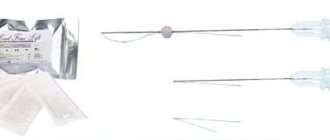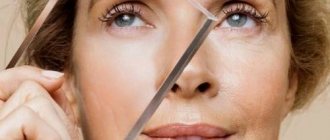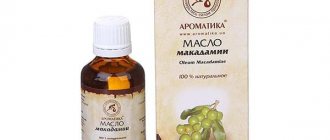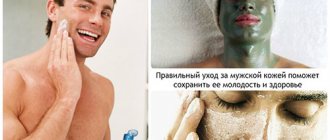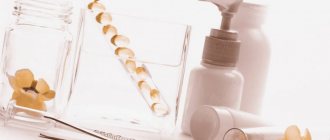When changes occur in cells and intercellular spaces with age that adversely affect the functioning of the most important systems of the human body, then it is customary to talk about skin aging, the natural physiological and pathological processes that each of us has to face over time.
- Skin aging processes
- Stages of natural age-related skin changes
- Types of skin aging
- Causes of facial skin aging
- How to slow down skin aging?
- Injection procedures
- Hardware procedures and peeling
- Prevention of skin aging
Age-related changes are caused by a genetic factor and depend not only on the period of a person’s life, but also on his habits, eating habits, sleep patterns, the environment in which he lives, as well as many other factors. The aging process of facial skin can begin as early as 25 years of age, developing gradually, but sometimes it happens later.
Causes of skin aging
With age, the skin of the face changes - wrinkles, age spots and other unpleasant signs of aging appear on it. Age-related changes affect all layers of the skin and there are a number of reasons for this.
The first and most important is a decrease in the content of elastin and collagen, which ensure firmness, smoothness and elasticity of the skin. In addition, the following can speed up the aging process:
- genetic predisposition;
- poor blood circulation;
- harmful effects of ultraviolet rays;
- smoking and drinking alcoholic beverages;
- poor nutrition;
- lack of proper skin care.
You can slow down the appearance of age-related changes and prolong youth by following simple recommendations from cosmetologists.
10. Lack of brain activity
The connection between life expectancy and cognitive activity has been scientifically proven. People of science, creativity, and teachers maintain sober thinking and beautiful appearance for a long time. The secret is being in a state of cognitive training. That is why older people are recommended to learn poetry and foreign languages, solve crosswords, in other words, active brain activity.
Although aging is a process that cannot be reversed, there are ways to slow it down. It doesn’t matter how old you are according to your passport, the main thing is how old you feel, because you can even age gracefully!
The first signs of facial skin aging
Let's start with the first sign of aging, the so-called “crow's feet” - a network of small wrinkles that appear in the outer corners of the eyes. The skin in these places is very delicate, so it is primarily subject to age-related changes. The insidiousness of “crow’s feet” is that they form after 20 years and become more and more noticeable over the years.
The main reason for their formation can be confidently called prolonged exposure to the sun. In addition, the appearance of wrinkles around the eyes is promoted by:
- overly active facial expressions;
- sudden weight loss, as a result of which the skin loses its elasticity;
- insufficient water content in the body;
- adverse atmospheric influences.
It is impossible to avoid such wrinkles, but you can delay their appearance if you try to exclude all of the above factors from your life.
And if “rays” do appear in the eyes, simple procedures will help to cope with them:
- Twice a day, apply oil containing vitamin E to the area around the eyes and massage gently for two minutes. For the same purpose, you can use pharmaceutical vitamin E capsules.
- Apply aloe vera gel to the area around the eyes before going to bed. It is advisable to perform this procedure daily.
- Another excellent remedy for crow's feet is compresses made from medicinal herbs.
How does facial modification occur?
Skin aging has certain stages. The first is characterized by a tired face. In this case, the elasticity of the soft tissues and neck decreases significantly, the corners of the mouth droop slightly, and the nasolabial fold becomes very pronounced. After sleep and rest, the face looks more youthful, but in the evening fatigue becomes noticeable.
The second stage - facial aging manifests itself in the form of wrinkles: the face and neck become covered with wrinkles, crow's feet form in the eye area, wrinkles of the upper and lower eyelids become more noticeable.
At the third stage, a double chin forms and the cheeks sag; deformation of the soft tissues of the face and neck also occurs, as a result the oval becomes different. People who have pronounced subcutaneous fat layer are susceptible to this type of aging.
The fourth stage combines all of the above symptoms in one: the elasticity of the dermis decreases, wrinkling of the face and neck appears, and deformation of the contours of the face occurs. The old face is less noticeable among representatives of Central Asia, Japan and Mongolia.
Residents of these countries have better developed facial muscles, but over the years they develop wrinkles called “crow’s feet.” To slow down skin aging and regain youth, you need to take care of your own face, you can make special corrections.
How to deal with wrinkles?
The appearance of wrinkles is another sign of skin aging. They appear most often on the face, neck and back of the hand.
The main factor in the formation of wrinkles is a decrease in collagen content in the skin. In addition, the cause of wrinkles can be:
- prolonged exposure to the sun;
- exposure to severe weather conditions;
- smoking and drinking alcoholic beverages;
- rapid weight loss;
- use of low-quality cosmetics;
- genetic predisposition.
The following measures will help reduce wrinkles or slow down the process of their formation:
- Massage problem areas daily using warm olive or coconut oil. Such procedures moisturize the skin well and promote its regeneration.
- And peeling using an oatmeal scrub will help you cope with wrinkles on the forehead. To do this, crushed flakes are mixed with one chicken egg yolk and a few drops of olive oil. Apply the composition to the skin of the face and wash off with warm water after 15 minutes.
External factors of aging
External factors that influence the rate of skin aging are based on one process - oxidative stress. When this happens, the body releases molecules called free radicals or reactive oxygen species. The free radical theory of aging states that we age due to the accumulation of damage from free radicals.
A free radical is a volatile atom or molecule that contains one unpaired electron in its outer shell. Most of them have the ability to severely damage all cellular structures, including lipids and proteins.
Under normal conditions, free radicals are captured and neutralized in the skin by antioxidants - molecules that can absorb and stop them. However, over time, the skin's ability to deactivate free radicals decreases. As a result, damage occurs to all components of the skin cell. Oxidative stress is accelerated and stimulated by various lifestyle factors.
Sun Rays Exposure to solar radiation is the main external factor responsible for skin aging associated with oxidative stress. Skin damage that is caused by both long-term and intermittent daily exposure to UV rays is called photoaging, which also affects uneven pigmentation.
Freckles and hyperpigmentation occur as a result of the skin's attempts to protect itself from the harmful effects of sunlight.
Pollution Skin contact with a variety of pollutants, especially in cities, can cause free radicals to form in the skin. In addition, pollution increases exposure to solar radiation, accelerating oxidative stress.
Urban pollution can accelerate the action of free radicals, especially when combined with sun exposure.
Smoking Chemical compounds and nicotine contained in cigarettes are responsible for increasing the amount of free radicals in the skin. Like pollutants, they increase the effects of sun damage, leading to oxidative stress.
Nutrition Antioxidants are molecules that can neutralize free radicals that damage the skin, accelerating its aging. If your diet lacks antioxidants, nutrition will not help slow down overall skin aging. But eating plenty of antioxidant-rich fruits and vegetables can be a key component of a comprehensive approach to preventing the aging process.
Not enough care If you don't take enough care of your skin, it will age faster. Thorough cleansing using products that are suitable for your specific skin type, combined with regular use of skincare products that target your skin's immediate needs, can make a noticeable difference to your skin. Using effective sun protection is a key part of prevention.
Dryness and flaking: skin oil and cream
The next sign of aging is dry, flaky skin. With age, the amount of hyaluronic acid in the body decreases, so the top layer of the skin becomes drier. The rate of cell renewal also decreases. The reason for this, in addition to the natural aging process, may be:
- dehydration;
- exposure to ultraviolet rays;
- excessive use of soap;
- harmful effects of dry air and hot baths;
- smoking and drinking alcohol;
- frequent stressful situations.
To combat dry skin, experts recommend:
- First of all, you should avoid hot baths and showers.
- After water procedures, the skin needs to be moisturized. It is better if a cosmetologist selects a skin moisturizer.
- In addition, you can apply a little olive oil to cleansed facial skin and then massage. After half an hour, rinse with water at room temperature and apply a light moisturizer to the skin.
- As an alternative to olive oil, it is acceptable to use honey or cosmetic milk. Apply the product to the skin, after 20 minutes rinse with water at room temperature.
Natural and premature aging
Scientists have proven that the type of human aging is determined by nature itself. However, several periods of skin aging can be distinguished. The aging process starts at the age of 25, which is caused by hormonal changes in the body and slower cell regeneration. Of course, at this age the body’s functional reserves are still quite high, so metabolic processes in it proceed quite quickly. The appearance of the first wrinkles at the age of 25 is usually associated with the influence of negative environmental factors on the skin.
Masks to combat sagging skin
The next age-related change is sagging and sagging skin. This occurs due to insufficient production of natural moisturizing components. In addition, the list of reasons for this unpleasant phenomenon can include:
- exposure to direct sunlight and ultraviolet rays;
- smoking and drinking alcohol;
- fast weight loss;
- poor nutrition;
- using products that are not suitable for this skin type;
- dehydration;
- exposure to aggressive chemicals.
Helps improve skin elasticity:
- Egg white mask. To do this, combine one protein with one tablespoon of regular yogurt or kefir and beat. Apply the composition to the face and neck area for 20 minutes, then rinse with water at room temperature. It is advisable to perform the procedure every other day.
- Cucumber masks tone, nourish and strengthen the skin well. The cucumber is crushed and applied to the face. After 15 minutes, wash off with warm water.
- A good way to combat sagging skin can be a massage using warm olive or coconut oil.
Causes – genes, behavior and pathological conditions
Many factors can accelerate aging, some of them are associated with pathologies, others are non-pathological in nature.
Factors that do not depend on diseases are:
- genetic factors: each person's genes may be more or less predisposed to certain diseases;
- environmental factors: some areas of residence carry a greater or lesser risk of disease;
- lifestyle: poor nutrition, sedentary lifestyle, smoking, alcohol and drugs can lead to damage to many organs, which accelerates physiological aging;
- sociocultural factors: older people who maintain social contacts or interests keep their brains active, and are less prone to dementia and depression;
- Sun: responsible for many skin changes due to the negative effects of ultraviolet rays.
Premature aging may be associated with the early onset of diseases characteristic of older people:
- Alzheimer's disease and other dementias: brain changes that cause memory loss and other cognitive dysfunction;
- diabetes mellitus: increased glucose levels requiring treatment with insulin;
- osteoporosis and osteoarthritis, which are associated with the loss of calcium from bones and articular cartilage;
- Parkinson's disease: a degenerative brain disorder that causes trembling and difficulty moving;
- urinary incontinence: inability to control urination;
- atherosclerosis and cardiovascular disease: hardening of the arteries due to atherosclerotic plaques increases the risk of heart attacks and strokes;
- cataracts and presbyopia: clouding of the lens and difficulty focusing on close objects;
- hypothyroidism: decreased production of thyroid hormones due to anemia, low body temperature and heart failure.
In addition, there is a group of rare genetic diseases that directly lead to unnatural and premature aging:
- Werner's syndrome
- progeria or Hutchinson-Gilford syndrome
- Down syndrome
- Bloom's syndrome
- trichothiodystrophy
- dermopathy
Causes of age spots and ways to eliminate them
Pigment spots can appear due to excess production of the pigment melanin. The reason for this may be either the natural aging process or:
- exposure to direct sunlight;
- skin injuries or burns;
- psychological stress;
- exposure to certain chemicals.
The most common areas for pigment spots are the face, back, and arms.
You can reduce pigmentation using simple procedures:
- Using a cotton pad, apply a little lemon juice to problem areas. Leave for 20 minutes, then rinse with water at room temperature. Perform the procedure twice a day. Lemon juice increases the photosensitivity of the skin, so this mask should not be used in the sunny season. After the procedure, you should definitely apply a cream with a high SPF filter.
- Before going to bed, apply aloe vera gel to problem areas. In the morning, wash your face with water at room temperature.
- To prevent excessive pigmentation in sunny weather, you should use sunscreens and skin lotions.
Care for aging skin
Key steps of care include:
- cleansing;
- hydration, nutrition;
- protection from negative influences.
Useful to use:
- Gentle products with avocado, sesame, and coconut oil are suitable for cleansing.
- Tonics with collagen and silk proteins will help raise your tone.
- Night creams - with avocado oil, day creams - with wheat extract.
- Hyaluronic acid – suitable as an eyelid product.
- Foundations will protect against harmful environmental attacks.
Care after 50 years includes not only high-quality creams, but also external influences. To look young, you need to improve your body's health. The diet requires vegetables, fruits rich in vitamins A, E and C, fish, olive oil, dried fruits, legumes - a source of Omega 3, Omega 6. Less salt should be consumed so as not to dehydrate the body. Drink about 2 liters of water per day. Avoid temperature contrasts.

